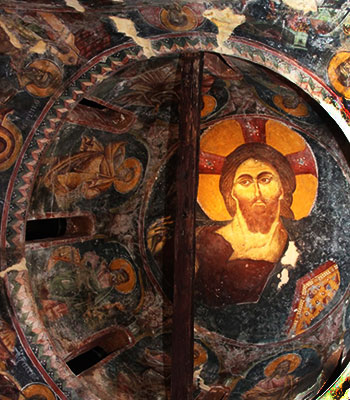 The church of Virgin Mary (Panagia) is the Catholicon of a destroyed monastery, dating back to the Venetian Rule era. According to the Venetian Archives of Candia (the Duke’s Archives-1368), the monastery was a fiefdom of Laurentius Maripero. On the northwest side of the Catholicon, there are the monastery cells and the rain water reservoir (sarnitsi), both of which are of no use today. The monument, according to the mural decoration, dates back to the second half of the 14th century. We can distinguish two different painting styles, one on the icons of the arch and one on the lower parts of the church.
The church of Virgin Mary (Panagia) is the Catholicon of a destroyed monastery, dating back to the Venetian Rule era. According to the Venetian Archives of Candia (the Duke’s Archives-1368), the monastery was a fiefdom of Laurentius Maripero. On the northwest side of the Catholicon, there are the monastery cells and the rain water reservoir (sarnitsi), both of which are of no use today. The monument, according to the mural decoration, dates back to the second half of the 14th century. We can distinguish two different painting styles, one on the icons of the arch and one on the lower parts of the church.
In mid-16th century the church belonged to the Venetian liege Franzesco DeMezzo, who gave it over to the monks Makarios and Parthenios Kontaris. DeMezzo’s mother, Diana, undertook the cost of repairing the church and making the iconostasis. From then on, Gouverniotissa had a period of great prosperity. Most of the icons that used to decorate the church belong to that period. Nowadays, they are kept in the Historical Museum of Heraklion. During the first years of the Ottoman Rule, the monastery was not mentioned in any record. Most probably, it was not an operational monastery any more or it had just declined. It is known, though, that it was passed on to the Magafouris family, who donated it to the Holy Sepulcher at the beginning of the 19th century. Thus, the monastery gained a great fortune. At that time, the Catholicon of the monastery was the parish church of the village of Potamies. The Holy Sepulcher sent a caretaker, who stayed in the premises for 4-6 years and took care of the church and its properties. Later on, the Exarch of the Holy Sepulcher himself stayed in the Gouverniotissa monastery. So, a building was constructed, next to the Catholicon, for the Exarch to stay. Today, this building is used as a photo exhibition hall. In 1929, the Exarch left the monastery and in 1937, after a government decision, the land that belonged to the monastery was expropriated and allocated to 70 landless farmers. The time that the Monastery of Panagia Gouverniotissa was established remains unknown.
The church is cruciform with a dome, but the west arm of the cross is longer than the others. The east arm forms the sanctuary, while all the arms form four different lower chambers, which are topped with groin vaults and are covered with tiles. The drum of the dome is actually pierced with eight windows, which are externally framed with eight blind arcades that are connected to each other with pillars. From the inside, the dome is decorated with the icon of Pantocrator (Almighty), an austere figure, full of motion. On the drum of the dome, Prophets are depicted and on the spherical triangles, Evangelists. On the east arm of the cross, which is in the sanctuary, and on the quadrant of the arch, there is the painting of Panagia Platytera (the Wider than the Heavens), surrounded by angels, while on the lower part of the alcove, there are the Communion of the Apostles and the Co-officiating Hierarchs. In the sanctuary, there are also depictions of the “Birth of Jesus”, the “Candlemas”, “Joseph’s Dream”, “Exodus”, and scenes from Jesus’ life. On the south arm of the cross, the wall paintings are divided into three zones, in each side of the arch. There are paintings that depict the “Raising of Lazarus”, the “Washing of the feet”, and the “Entry into Jerusalem”. On the south wall of the arm, we see the “Wedding at Cana”, the “Multiplication of the loaves” and scenes from Virgin Mary’s life. On the west wall, three monks are depicted, on the lower part of the zone, two full-size military saints and on the east wall, Virgin Mary with Jesus, surrounded by angels. On the west arm of the cross there are depictions of the “Betrayal of Judas”, “Christ before Pilate”, “Peter denies Christ”, “Christ carrying the cross”, the “Mocking of Christ”, “Pilate washing his hands”, “Nicodemus claims the body of Christ”, the “Crucifixion”, “Jesus among angels” and the “Myrrh-bearing women at the tomb of Christ”. On the west wall, there are the “Assumption of Mary” and on the north and south walls, full-size images of female frontal Saints, with fine facial features and florid attire. On the north arm of the cross, even though it is quite destroyed, discernible are still scenes from Virgin Mary’s life, as well as from some miracles, such as “Jesus healing the blind”, “Christ healing the paralytic”, and “Christ and the Samaritan Woman”.
The church of Panagia Gouverniotissa is one of the most important monuments of the Palaiologan Period on Crete. The paintings have been clearly influenced by illustrated manuscripts and the western iconography. The intense narrative and the quality of the execution associate the monument with the so-called Macedonian School. Gouverniotissa has retained its splendor as a religious monument up to the present day. On 15th August, every year, one of the greatest festivals of the region is held on its premises.
Architecture: cruciform with a dome
Dating: 1350 – 1375
Location: Northwest of the village Potamies - Panagia or Peristera (Dove) area
Celebration: 15th August
Hagiography: YES
Access : Relatively easy access from a country road
Visit Options: Open. Visitors can also call on the following tel. number: +30 6972323300